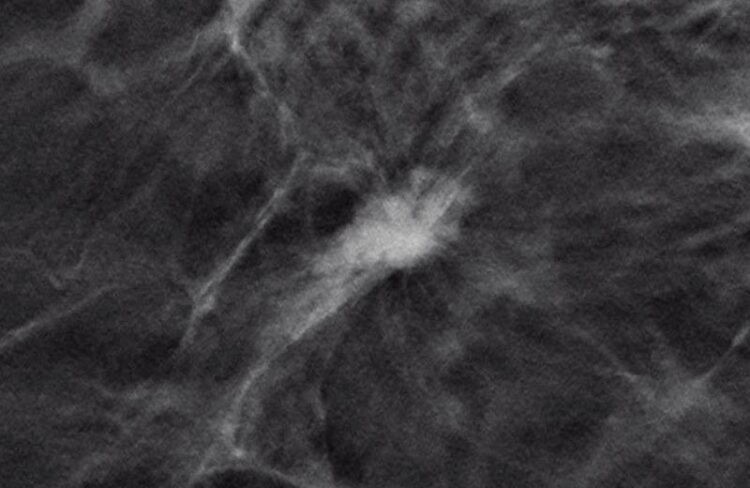Early breast cancer detection

Digital breast tomosynthesis of the left breast showing a spiculated mass of increased density. Histology: Invasive lobular breast carcinoma grade 2.
(c) Uni MS/AG TOSYMA
Further TOSYMA analysis underpins advantages of DBT+SM use.
Early detection of disease is considered positive – but what if it finds “too much”? While early diagnosis can improve the chances of recovery, early detection can also have unwanted side effects. After all, not everything that is found would have become life-threatening in the course of the disease. TOSYMA, the world’s largest randomized diagnostic superiority study on early breast cancer detection, has now investigated whether the innovative DBT+SM method for early breast cancer detection also has such an effect – and was once again able to hint on advantages of the approach over the screening standard by finding more early tumor stages of tumor grades 2 and 3.
In diagnostics, finding more is not automatically better. Rather, it is about finding the right thing – especially in the case of such dangerous diseases as cancer. This is where early detection comes into play, but it can also have unwanted side effects: For example, there is a risk of also discovering non-aggressive tumors that lead to treatment – but would not have substantively impaired quality of life or become life-threatening in the course of the disease. Medicine speaks of overdiagnosis. TOSYMA is also about early detection: the world’s largest randomized – i.e. randomly assigned – diagnostic superiority study for the early detection of breast cancer has set itself the task of investigating and improving the systematic early detection of invasive breast cancer. The researchers at the University of Münster, who are managing the mammoth project, have now published new results on TOSYMA in the highly ranked journal “Radiology”. These demonstrate the advantages of the innovative diagnostic approach.
A combination of DBT – short for Digital Breast Tomosynthesis – and Synthetic 2D Mammography (SM) was used for the almost 100,000 TOSYMA study participants. The interdisciplinary study group led by Prof. Walter Heindel, Director of the Clinic for Radiology at the University Hospital Münster, compared the data obtained with the combined procedure – known as DBT+SM – with that from conventional screening with digital mammography (DM). The result: DBT+SM leads to the detection of significantly more invasive breast cancers compared to the conventional DM procedure. However, this does not necessarily mean that women’s health is improved – the keyword here is overdiagnosis. In other words, it has been shown that DBT+SM “finds” breast cancer better – but the task now was to investigate whether this can be expected to actually lead to an improvement for the affected breast cancer patients.
In an exploratory subanalysis, Prof. Stefanie Weigel, Prof. Walter Heindel and Prof. Hans-Werner Hense examined which tumors are frequently detected at an earlier stage of breast cancer – and found that DBT+SM screening can detect relevant tumors, i.e. those that – in contrast to less aggressive variants – are potentially relevant for a reduction in breast cancer mortality. Prof. Stefanie Weigel concludes: “From the results of the subanalysis, we conclude that the higher rate of early tumor stages of tumor grades 2 and 3 through the use of DBT+SM could increase the screening effect with regard to breast cancer mortality” – another “plus point” for DBT+SM.
The next step is already in progress: this year, data from the cancer registries of North Rhine-Westphalia and Lower Saxony will be evaluated for follow-up in order to further examine the screening effect of DBT+SM compared to the previous screening standard. The TOSYMA project began in 2016, comprises 17 screening units in Germany and is financially supported by the German Research Foundation. The current funding period runs until 2025.
Wissenschaftliche Ansprechpartner:
Prof. Dr Walter Heindel
University of Münster
Klinik für Radiologie des Universitätsklinikums Münster
E-Mail:heindel@uni-muenster.de
Phone: 0049 251 8345650
Originalpublikation:
https://doi.org/10.1148/radiol.231533
Weitere Informationen:
https://www.medizin.uni-muenster.de/tosyma ToSyMa Study at the University of Münster
Media Contact
All latest news from the category: Medical Engineering
The development of medical equipment, products and technical procedures is characterized by high research and development costs in a variety of fields related to the study of human medicine.
innovations-report provides informative and stimulating reports and articles on topics ranging from imaging processes, cell and tissue techniques, optical techniques, implants, orthopedic aids, clinical and medical office equipment, dialysis systems and x-ray/radiation monitoring devices to endoscopy, ultrasound, surgical techniques, and dental materials.
Newest articles

Innovative 3D printed scaffolds offer new hope for bone healing
Researchers at the Institute for Bioengineering of Catalonia have developed novel 3D printed PLA-CaP scaffolds that promote blood vessel formation, ensuring better healing and regeneration of bone tissue. Bone is…

The surprising role of gut infection in Alzheimer’s disease
ASU- and Banner Alzheimer’s Institute-led study implicates link between a common virus and the disease, which travels from the gut to the brain and may be a target for antiviral…

Molecular gardening: New enzymes discovered for protein modification pruning
How deubiquitinases USP53 and USP54 cleave long polyubiquitin chains and how the former is linked to liver disease in children. Deubiquitinases (DUBs) are enzymes used by cells to trim protein…



